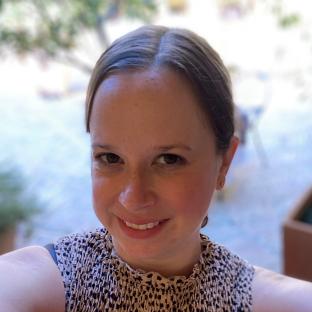Biography
Sarah Vordenberg is a clinical associate professor at the University of Michigan College of Pharmacy. She teaches first year students in the Doctor of Pharmacy program and oversees community health initiatives with two organizations in Ann Arbor. Her scholarship focuses on psychological factors that influence older adults willingness to stop medications and the scholarship of teaching and learning.
Pharmacy School Attended: Northeast Ohio Medical University (2012)
Other Training:
- PGY1 Community: Kroger –Ohio Northern University (2013)
- Fellowship: Decision Sciences, Center for Bioethics and Social Sciences in Medicine (2020)
- Master of Public Health –Northeast Ohio Medical University (2013)
Areas of Interest
Psychological factors that influence older adults willingness to stop medications, Scholarship of teaching and learning with an emphasis on virtual simulation, Expansion of pharmacists in community health
Honors & Awards
Selected for the American Association of College of Pharmacy Academic Leadership Fellows Program 2022
Outstanding Reviewer, Journal of the American Pharmacists Association 2018, 2022
Selected for the US Deprescribing Research Network Junior Investigator Intensive 2021
Teaching Excellence Award, University of Michigan College of Pharmacy 2020
Fellow of Michigan Pharmacists Association 2019
Student Appreciation Award, University of Michigan College of Pharmacy P1 Class 2018
Rho Chi Society, University of Michigan Alpha Chapter 2018
Selected as an Interprofessional Leadership Fellow, University of Michigan 2017
Pharmacist of the Year, Hope Clinic, Ypsilanti, Michigan 2016
MeRIT Program Scholarship, Education and Training PRN of the American College of Clinical Pharmacy 2016
APhA-APPM Presentation Merit Award for Contributed Research, American Pharmacists Association 2016
Published Articles or Reviews
- Vordenberg SE, Zikmund-Fisher BJ. Older adults’ strategies for obtaining medication refills in hypothetical scenarios in the face of COVID-19 risk. J Am Pharm Assoc. [in press]
- Vordenberg SE, Zikmund-Fisher BJ. Characteristics of older adults predict concern about stopping medications. J Am Pharm Assoc.[in press]
- Tai MH, Rida N, Klein KC, Diez H, Wells T, Kippes K, Walker PC, Vordenberg SE. Impact of virtual simulation in self-care therapeutics course on introductory pharmacy practice experience self-care encounters. Curr Pharm Teach Learn. 2020; 12(1):74-83.
- McPhail EJ*, Marshall VD, Remington TL, Vordenberg SE. Readmission rates associated with pharmacist involvement in a geriatric transitional care management clinic. Innov Pharm. 2019;10(3):Article 20.
- Vordenberg SE, Lindell V, Sheerer K, Settles A, Fan AL, Serlin DC, Parker-Featherstone E, Bernstein SJ, Choe HM. Improving hypertension control through a collaboration between an academic medical center and a chain community pharmacy. J Am Coll Clin Pharm. 2019;2(4):357-365.
- Klein K, Vordenberg SE, Pais K, Lee C, Bostwick J. From clinical assistant to clinical associate professor: Examination of a sample of promotion guidelines. Curr Pharm Teach Learn. 2019;11(4):346-351.
- FarhatNM, Vordenberg SE, Marshall VD, Suh TT, Remington TR. Evolution of interdisciplinary geriatric transitions of care on readmission rates. Am J Manag Care. 2019;25(7):e219-e223.
- Anderson OS, Hisamatsu R, Dubin L, Mergos J, Vordenberg SE.An asynchronous, interprofessional teams and teamwork experience for the first-exposure learner. JIEP. 2019;14:47-52.
- Lee CA, Pais K, Kelling SE, Anderson OS. A scoping review to understand simulation used in interprofessional education. JIEP. 2018;13:15-23.
- VordenbergSE, Smith MA, Diez HL, Remington TL, Bostwick JR. Using the plan-do-study-act (PDSA) model for continuous quality improvement of an established simulated patient program. Innov Pharm.2018;9(2):Article 19.
- Lindell VA, Azar M, Telega E, Kelling SE. Review of community based organization and community pharmacy partnerships for preventive care services. Innov Pharm. 2018;9(2):Article 8.
- Ambroziak K, Ibrahim , Marshall VD, Kelling SE. Virtual simulation to personalize student learning in a required pharmacy course. Curr Pharm Teach Learn. 2018;10(6):750-756.
- Zhang S, Soreide KK, Kelling SE, Bostwick JR. Quality assurance processes for standardized patient programs. Curr Pharm Teach Learn. 2018;10(4):523-528.
- Bazzell B, Kelling S, Diez H, Klein K. Identifying opportunities for improvement in safety and efficacy of community pharmacy immunization programs. J Pharm Pract. 2019 Aug;32(4):428-433.
- Kelling SE, Walker PC, Mason JG*, Zara N*, Bleske BE. Incorporation of a community pharmacy-based heart failure assessment tool by advanced pharmacy practice experience students. J Am Pharm Assoc. 2017;57(3):382-388.
- Kelling SE. Look-alike/sound-alike dietary supplements. J Am Pharm Assoc.2017;57(3):300-301.
- DiPietro Mager NA, Bright DR, Murphy BL, Rondon-Begazo A, Kelling SE. Opportunities for pharmacists and student pharmacists to provide clinical preventive services. Innov Pharm. 2017;8(1):Article 11.
- Kelling SE, Rondon-Begazo A,DiPietro Mager NA, Murphy B, Bright D. Provision of clinical preventive services by community pharmacists. Prev Chronic Dis 2016;13;160232.
- Kelling SE, Pattin A, Abdulbaset S, Kilgore P, Erickson S. Cross-sectional survey of perceived barriers among community pharmacists who do not immunize in Wayne County, Michigan. Infect Dis Ther 2016;Sept 15.
- Kelling SE. Exploring accessibility of community pharmacy services. Innov Pharm. 2015;6(3): Article 210.
- Keller ME, Kelling SE, Cornelius DC, Oni HA, Bright DR. Enhancing practice efficiency and patient care by sharing electronic health records. Perspect Health Inf Manag. Fall 2015:1-18.
- Keller ME, Kelling SE, Bright DR. Pharmacy technicians and point of care testing. J Pharm Tech. 2015;31(4):143-48.
- Pattin AJ, Kelling SE, Szyskowski J, Izor M, Findley S. The redesign of a community pharmacy internship program. JPP. 2015;1-4.

